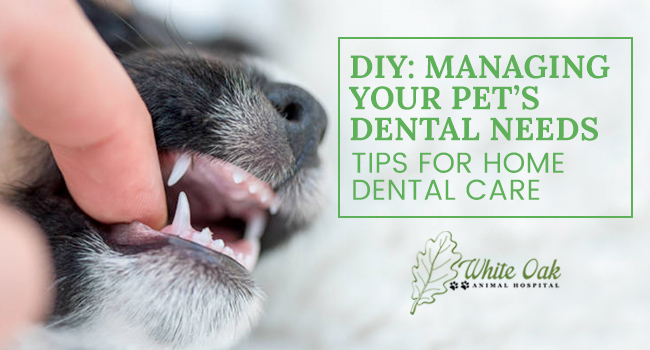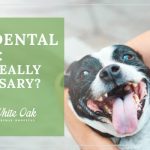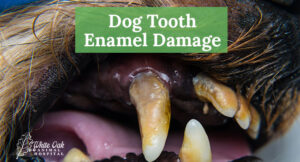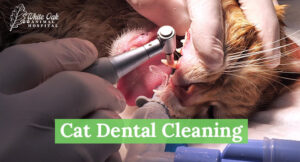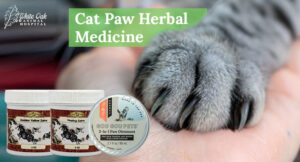Looking for ways to manage your pet dental care needs at home?
While we stand behind the fact that NOTHING is as effective as a good ol’ fashioned dental from your vet, there are things you can do between dental cleanings to help.
You may need to try several of the following methods to determine which one is best for you and your pet. Don’t be surprised if you end up using a combination of these methods! Before we get started, let’s lay down some good guidelines.
Pet Dental Care: At-Home Basics
#1) PATIENCE. However you can, instill the importance of patience into your brain. PATIENCE is key, that is if you really want to establish a dedicated pet dental routine with your pooch (and maybe even some kitties out there, too)!
#2) No matter what method you choose, stick to it. At-home care every single day is ideal, but we get that there aren’t 2,700 hours in a day. 2-3 times per week is the minimum we recommend for effectiveness. Bottom line…once or twice a month isn’t going to cut it.
#3) DO NOT (for Pete’s sake) use human toothpaste on your pet!
The Manual Method: If Only Dogs Said ‘Ahhhhhh!’
Of all the dental home methods, brushing your pet’s teeth is probably the most effective way to go. Truthfully, pet dental care is not too far-fetched from your own dental care! Let’s elaborate…
Unless you are already using pet-approved, chicken-flavored toothpaste, a trip to the pet store is probably in your near future. You will probably find several other scrumptious flavors while there, too! This will hopefully play out in your favor when it’s brushing time. Over time, you may even find your dog likes certain flavors.
You’ll also run into a variety of toothbrushes: regular brushes, angled brushes, dental pads/wipes, finger brushes, etc. Deciding which to buy should be based solely on your preference and ease of use.
The friction of the brush against the tooth is the main goal here. The friction alone is enough to disrupt and remove the odor-causing bacteria that adhere to the tooth surface. By disrupting the build-up of the bacteria, you also cut down on the formation of plaque.
Not As Easy As You Expected? That’s OK!
Until a regular routine is established, or if Fluffy’s patience is as long as my toddler’s, it is advisable to focus on the ‘cheek teeth’. And yes, cheek teeth are exactly what they sound like…the back teeth (or molars) that line the jowls. Molars are used for grinding and chewing food. Therefore, that is where MOST plaque forms and builds up (and as a technician that has done plenty of dentals, I can attest to that!)
Ideally, every single tooth and every side of every tooth should be brushed. Realistically, we know that’s not going to happen in most cases. (Hence the reason we HIGHLY recommend professional anesthetic pet dental cleanings on a routine basis, as does the AVDC.)
Just remember, slow and gradual is key. All of the teeth may not get brushed the first, second or even the tenth time. But as long as you are making forward progress, you’re doing something!
Just be consistent and, above all, SAFE!
Oral Rinses/Water Additives
For a person looking for an easier route, water additives or oral rinses may be for you. All you need is the product of your choice, your pet, and some fresh drinking water daily! Now I’ll clue you in on what to look for when choosing a product.
In the vet world, we have a little germ-slaying friend called chlorhexidine. From surgery to wound management to oral health, chlorhexidine is a powerhouse against bacteria. Like everything else today, you will find tons of oral rinses on the market. It’s likely you’ll find different forms of this product as well. Water additives, oral gels to rub on the teeth/gums, and oral rinses to squirt in the mouth are some common ones.
Nevertheless, the main thing to look for on the ingredient panel is chlorhexidine. Because of its ability to attach itself to the tooth surface and gums, it has been proven to be one of the most effective antiseptics against plaque-causing bacteria. The only downfall is it is bitter-tasting when given alone. We recommended purchasing a product with flavor added if possible.
Bones, Treats & Toys
Now we have the ‘Sparky can clean his own teeth’ option. From rawhide bones to specialized diets, the choices are endless. And I’m not ashamed to tell you this vet tech uses this method regularly!
Most dogs have a natural urge to chew, which could be a win-win for you and your pet. The concept here is to allow your dog to chew on things, such as bones or specialized pet dental toys, in order to break away tartar and build up from the teeth.
The only qualification is…a dog that likes to chew!
Ensuring that your pet continues to chew on their favorite bone or toy often is important as well. 2-3 times per week is the minimum recommended for effectiveness.
When using bones and toys, we recommend closely monitoring your pet to see what kind of chewer he or she may be. We suggest only allowing your pet to have items such as these when you are around to safely monitor them.
We also suggest keeping a close check on toys and bones for loose or broken pieces. Chewing is good…ingesting foreign objects is not!
If your dog is the type to swallow things whole or doesn’t take the time to chew food or treats, this may not be the choice for you. Not only could it be dangerous, it will not be effective.
***NOTE*** The AVDC (American Veterinary Dental College) does not recommend cow hooves, dried natural bones or hard nylon products because they are simply too hard. In some cases, broken teeth and damaged gum tissue have resulted. If used, use with extreme caution!
There are several oral chews on the market. Some are even formulated with ingredients to help prevent plaque from adhering to the teeth. Oravet is a popular brand we trust.
To DIY or Not to DIY?
Doing something for oral health is most certainly better than doing nothing at all. However, these at-home options are not meant to replace a dental done by your veterinarian (and yes, under anesthesia). Nothing has proven to be more effective.
Take it from a tech who’s been in plenty of rotten dog mouths…don’t wait until there is a problem. Get ahead of your pet’s oral hygiene and prevent plaque build-up before it starts!
Have questions or suggestions? Comment below! We’d love to hear!
Related Posts
-
Are Dental Cleanings for Pets Necessary?
I can usually count on it at least once a week. I follow the…
-
When Should I Spay or Neuter My Pet?
Should I Spay or Neuter My Pet? For many years, veterinarians recommended clients spay or…
-
What Every Pet Owner Should Know About Pet Allergies
Whether human or pet, allergies usually prove to be a complicated, and sometimes frustrating, topic.…
-
The Best Way to Get Rid of Cat Allergies Naturally
Would You Like to Know How to Get Rid of Cat Allergies Naturally? Like people,…

